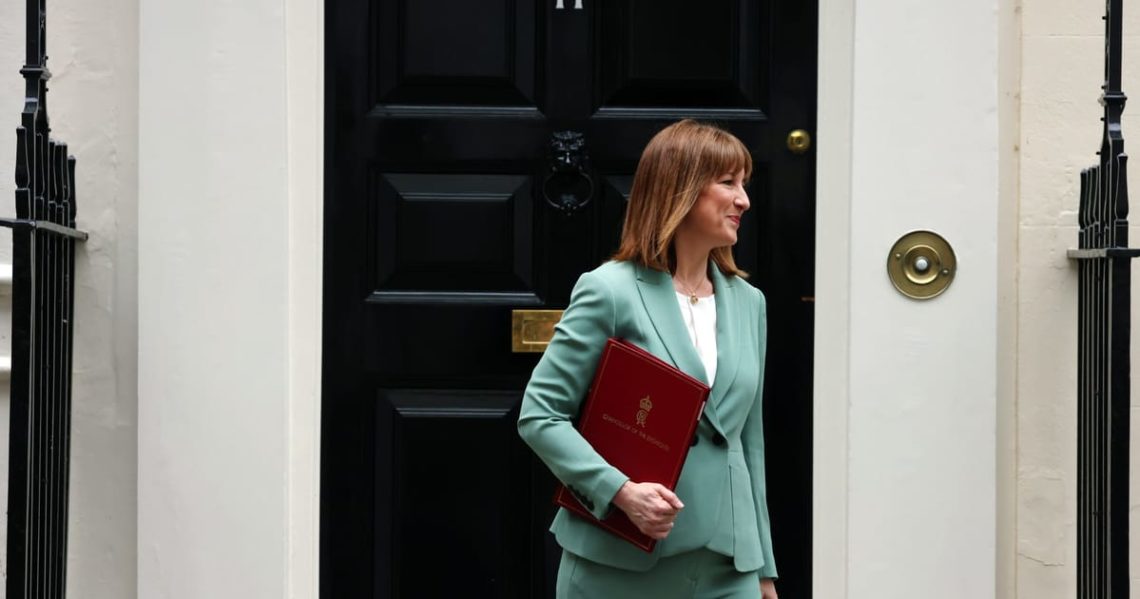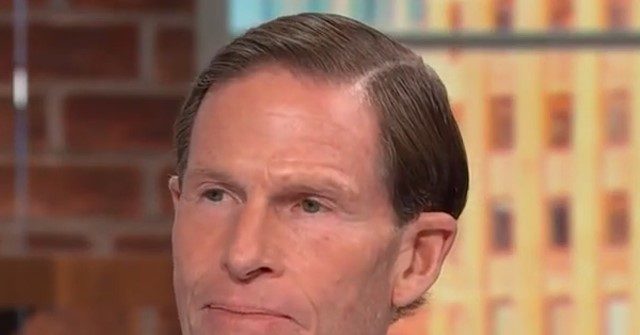LONDON — For a politician who spent the last year warning of a “black hole” in the public finances and doling out misery, Rachel Reeves was practically popping corks.
The U.K.’s finance minister promised nothing less than “the renewal of Britain” in her review of government spending Wednesday, which set the framework until the next general election in 2029.
Her narrative (along with £113 billion of capital investment) was aimed squarely at countering the threat of Reform UK, the upstart populist party now leading opinion polls. During her speech in parliament, Reeves took time out to poke fun at Reform leader Nigel Farage, who was sitting across the Commons chamber, laughing with his colleagues.
But Reeves also admitted many voters feel a “sense that something has been lost” as she pledged to redirect cash beyond London to poorer areas where Farage poses a significant political threat. “The renewal of Britain must be felt everywhere,” Reeves said.
Overall, she sought to strike a far more positive tone than she had done in the past. Reeves said “we are starting to see the results” of fiscal rectitude, with interest rate cuts and growth in GDP and real wages.
It felt like an election pitch, four years early. The question is whether this is as good as it will get.
For one thing, the Chancellor’s buoyant mood was at odds with the scale of her spending plans, and the pain they will inflict on some areas of the state.
In truth, she is unable to put much taxpayers’ money where her mouth is because there’s not enough to go around: Reeves is hemmed in by a key election pledge not to raise major tax rates, her own fiscal rules and Britain’s vast public sector debt.
Her plan contained tight spending settlements for many U.K. government departments, including the Foreign Office and the Home Office, especially from next year. Nervous ministers believe these could force a reality check on Labour’s mission to rebuild the state.
In these seven takeaways, POLITICO examines the reality of Reeves’ spending review:
1) Don’t call it austerity: The money is real
This is no throwback to the Conservative austerity of the early 2010s, when almost every department underwent steep real-terms cuts — several by more than 20 percent.
Reeves and her aides boast that total “departmental expenditure limits” will grow by 2.3 percent a year in real terms between 2023/24 and 2028/29. (Though this rise is only 1.2 percent for day-to-day revenue spending from 2025/26. More on that spin shortly.)
“Austerity was a destructive choice for the fabric of our society,” Reeves told MPs. “My choices are different.”
In an age of trade and land war, Reeves even harked back to her Bidenomics-inspired mantra of “securonomics” — using the state’s heft to kickstart homegrown manufacturing. The Chancellor’s critics thought she had parked that idea while seeking economic ties with China.
2) But it’s no splurge either: Where the knife falls
Revenue spending in several departments will fall sharply in real terms by 2028/29.
Some of these seem to have easy explanations. Government officials say a 5 percent real-terms cut in day-to-day Department for Transport spending is due to scaling back post-Covid railway subsidies. A real-terms cut of 1.7 percent a year for the Home Office is mostly down to a pledge to end spending on hotels for asylum seekers by 2029, officials say.
But ministers are being forced to tighten their belts. The Department for Environment, Food and Rural Affairs faces a real-terms cut of 2.7 percent a year, while Business and Trade spending is cut by 1.8 percent and the Department for Culture, Media and Sport by 1.2 percent.
The U.K. Foreign Office faces steep cuts of 6.9 percent per year, largely in the form of February’s decision to slash foreign aid spending.
Day-to-day spending in the Department for Education will rise by 0.7 percent a year — yet most of this is accounted for by a big expansion of free school meals, said Paul Johnson, director of the nonpartisan Institute for Fiscal Studies (IFS) think tank.
3) Whitehall gets a haircut: Civil Service jobs
Starmer’s Cabinet cheerleaders have made a big deal of “efficiency” in government. The review puts (some) flesh on what that’ll mean.
Government departments (known collectively as Whitehall after the street in Westminster where many are based) are expected to cut their administration budgets by 10 percent by 2028/29, and 15 percent (£2.2 billion a year) by 2029/30.
Departments also need to find “efficiency gains” averaging 4 percent by 2028/29, a total of £13.8 billion per year. HM Revenue and Customs plans to save 13.1 percent of its spending through “AI and automation” and basing 85 percent of staff outside London, while the Department for Work and Pensions will use artificial intelligence to review jobseekers’ CVs.
Eleven central London government offices will be closed, including 102 Petty France (currently home to the Ministry of Justice) and 39 Victoria Street (used by the Department of Health), while overseas allowances for British diplomats are — hold on to your canapés — “being reviewed and revised.”
Some of the precise calculations behind these efficiency savings still lack detail, though — and officials have declined to say exactly how many civil service jobs will be lost as a result.
4) The small print hurts: building homes
The chancellor rattled off big numbers (often shorn of context) to prove she is opening the spending taps. As always, the devil is in the detail.
Many figures in the spending review are measured from the start of “phase one,” 2023/24 — when the Conservatives were still in power. Spending becomes far tighter in “phase two,” which starts from next year. Real-terms increases in day-to-day spending will slow from 2.7 percent in 2024/25 to just 1 percent a year from 2027/28.
Some headline numbers are also spread over long periods. Reeves promised to deliver Labour’s manifesto pledge to build 1.5 million homes by 2029 with a £39 billion Affordable Homes Programme. Yet this is spread over a decade, and will only hit its stride (£4 billion a year) by 2029/30, around the time of the next election. Labour MPs will want to see houses built, and voters moving in, ASAP.
Some sums are not all provided by central government. Reeves said she was raising “spending power” for police forces and councils — subject to tense last-minute negotiations — but this is based on individual councils deciding to hit voters with above-inflation rises in council tax.
A £113 billion rise in capital investment by 2029 looks generous. But the National Institute of Economic and Social Research (NIESR), a nonpartisan think tank, argued it is a figure that Reeves has measured against past plans for cuts that were “implausible.”
5) Bigger isn’t big enough: health and defense
Britain’s plans for defense spending will soon butt up against reality.
Defense spending will meet the U.K.’s target of 2.6 percent of GDP (including intelligence agencies) from 2027 onwards, but the review has no firm plans to raise it further. This is despite Labour’s “ambition” to hit 3 percent by 2034. More pressingly, NATO is holding talks with allies about raising their commitments to 3.5 percent. Discussions will reach a crunch point at the alliance’s summit later this month.
The jewel in Reeves’ announcement was a 3 percent-per-year rise in spending on Britain’s ailing National Health Service. But this is less than what has been the average annual rise since the 1970s, of 3.8 percent.
Johnson, the IFS boss, said Labour’s target to reduce treatment waiting times below 18 weeks will be “enormously ambitious – an NHS funding settlement below the long-run average might not measure up.”
6) Peter pays Paul: energy
The budget of the U.K.’s new publicly-owned power company, Great British Energy, has been raided to fund a longstanding government commitment to develop mini nuclear reactors.
Labour’s manifesto committed to £8.3 billion over five years for GB Energy to “deliver clean power” projects across the country. But Wednesday’s review assigned £2.5 billion of its funding package to a deal to develop small modular reactors (SMRs) — small-scale nuclear plants that will be relatively quick to build — including through a partnership with Rolls-Royce.
Two government officials denied that the decision amounted to a cut to GB Energy’s budget, though a third government official said the decision had come “very last minute.”
7) This is not the end: Will taxes have to rise?
Reeves pitched her plan as a return to “stability,” vowing not to revisit the settlements until the next spending review, in 2027. But with a full budget due this fall, Treasury aides accept speculation about her next move will begin almost immediately.
The NIESR said it was “almost inevitable” that taxes will need to rise — a warning leapt on by opposition MPs. Conservative Shadow Chancellor Mel Stride branded Reeves the “spend today, tax tomorrow chancellor.”
Key details of the government’s plans are also yet to be unveiled. A 10-year infrastructure strategy and an industrial strategy are each due later in June, with a 10-year plan for the NHS, a national security strategy and audit of Britain’s relations with China all expected to follow in the coming months.
Then there are — potentially — holes that departments will need to fill later.
Wednesday’s spending review warns pay rises for Britain’s 6 million public sector workers will need to be funded from departments’ existing budgets until 2029. Departments have estimated what these pay rises might be, but there won’t be certainty for years.
At some point, someone will have to pay up. Reeves will be hoping it’s not her.
Charlie Cooper contributed reporting.
The post Seven reality checks on Britain’s sunshine spending review appeared first on Politico.




